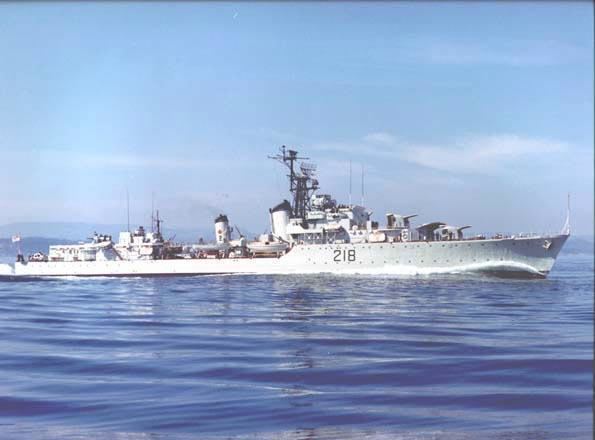Name Cayuga Ordered April 1942 Commissioned 20 October 1947 Construction started 7 October 1943 Length 115 m Builder Halifax Shipyard | Namesake Cayuga nation Laid down 7 October 1943 Decommissioned 27 February 1964 Launched 28 July 1945 Draft 2.7 m | |
 | ||
Hmcs cayuga r04
HMCS Cayuga was a Tribal-class destroyer that served in the Royal Canadian Navy from 1946 until 1964. She saw action in the Korean War. She was named for the Cayuga nation, a First Nations people of Canada.
Contents
Cayuga was ordered in April 1942 as part of the 1942 building programme. She was laid down on 7 October 1943 by Halifax Shipyards at Halifax, Nova Scotia and launched 28 July 1945. Cayuga was commissioned on 20 October 1947 at Halifax with the pennant number R04.
Service history
On 4 February 1948, Cayuga transferred to the west coast for Esquimalt, British Columbia. In October 1948, Cayuga joined the cruiser Ontario, destroyers Athabaskan, Crescent and the frigate Antigonish in sailing to Pearl Harbor, Hawaii; the largest deployment of the Royal Canadian Navy following the war. In March 1950, with Ontario and Sioux, the destroyer participated in a training cruise to Mexico, making several port visits.
Korean War
Cayuga served a total of three tours of Korea, the last in 1954 after the conflict had ended. Cayuga was part of this initial first dispatch of three ships by Canada to Korea, departing Esquimalt on 5 July 1950. In 1952, Cayuga was reconstructed as a destroyer escort and given the new hull number 218. It was on this vessel that Ferdinand Demara, "the great impostor", served while impersonating a Canadian medical officer.
After the Korean War, Cayuga served as a training ship on the west coast. On 1 January 1955, Cayuga was assigned to the Second Canadian Escort Squadron. The initial commanding officer of the group was Commander Henry H. Davidson, captain of Cayuga. In November 1955, the Second Canadian Escort Squadron was among the Canadian units that took part in one of the largest naval exercises since the Second World War off the coast of California. In January 1959 she transferred back to Halifax. There the destroyer escort served as a training ship until being paid off on 27 February 1964. The destroyer was sold for scrap and broken up at Faslane, Scotland in 1965.
RCSCC Cayuga
In 1942 the 140th Royal Canadian Sea Cadet Corps was created and named after HMCS Cayuga, and continues to operate to this day, on CFB Wainwright, Alberta. The Coxswain of 140 RCSCC Cayuga, as is the Corps' formal title, is Cadet Chief Petty Officer First Class (CPO1) D. Cummins. The Commanding Officer is C. I. C. Captain E. Belanger, and the Executive Officer is C. I. C. A/slt. L. Jeckells.
The only difference between the crests of 218 HMCS Cayuga and 140 RCSCC CAYUGA is that the maple leaves at the bottom of the crest are red on the RCSCC version whereas they appear gold on the original.
